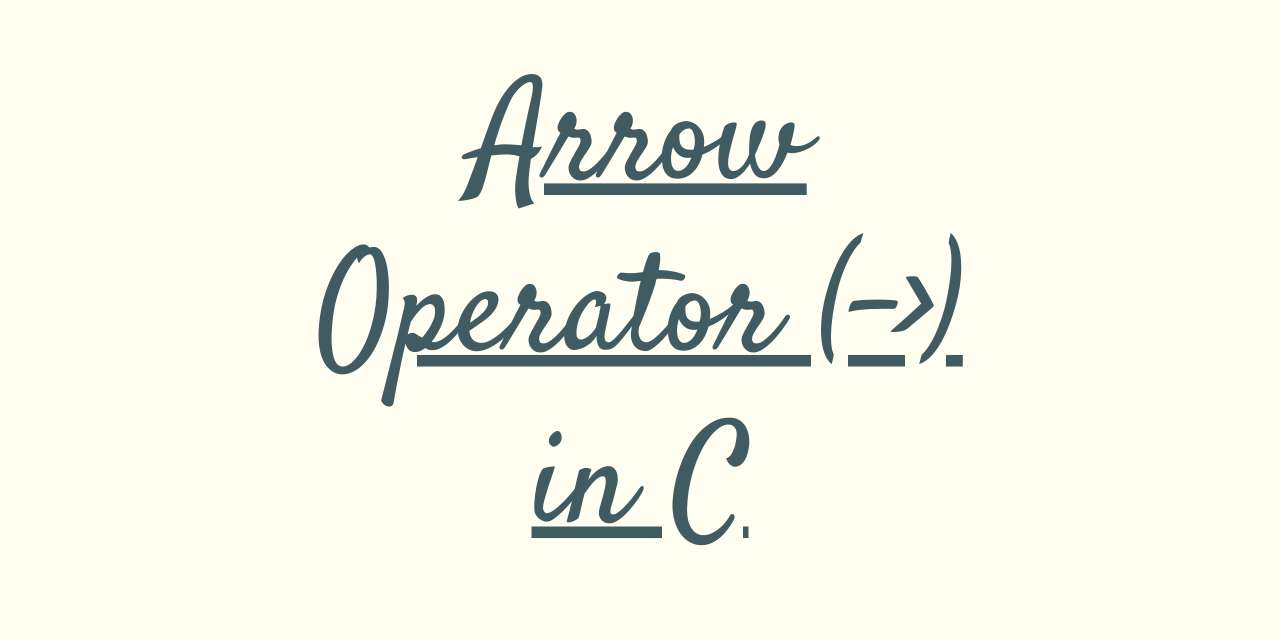- Log in to:
- Community
- DigitalOcean
- Sign up for:
- Community
- DigitalOcean
By Safa Mulani

Hey, folks! In this article, we will be focusing on Arrow operator in C. C language comprises of various operators to deal and manipulate the data records. One such operator is the Arrow operator.
So, let us begin!
Working of Arrow operator in C?
In C, this operator enables the programmer to access the data elements of a Structure or a Union.
This operator(->) is built using a minus(-) operator and a greater than(>) relational operator. Moreover, it helps us access the members of the struct or union that a pointer variable refers to.
Let us now focus on the structure of Arrow operator in C.
Syntax of Arrow operator(->)
Have a look at the below syntax!
(pointer variable)->(variable) = value;
The operator is used along with a pointer variable. That is, it stores the value at the location(variable) to which the pointer/object points.
Let us now implement this operator through some examples in the upcoming section.
Examples of Arrow operator (->)
In the below example, we have created a Structure ‘Movie_info’. Further, we have assigned a pointer object to the structure and allocated memory to it in a dynamic manner using the C malloc() function.
Arrow operator to access the data member of a C Structure
#include <stdio.h>
struct Movie_info
{
char *name;
char *ACC;
};
int main()
{
struct Movie_info* M;
M = (struct Movie_info*)
malloc(sizeof(struct Movie_info));
M->name = "Python with JournalDev";
M->ACC="A";
printf("Movie Information:");
printf("\nName: %s", M->name);
printf("\nACC: %s", M->ACC);
return 0;
}
We have accessed the values of the data members using arrow operator(->).
Output:
Movie Information:
Name: Python with JournalDev
ACC: A
Let us now try to access the data members of Union using arrow operator. Arrow operator to access the data members of Union in C
#include <stdio.h>
union Movie_info
{
int id;
float net_val;
};
int main()
{
union Movie_info* M;
M = (union Movie_info*)
malloc(sizeof(union Movie_info));
printf("Movie Information:\n");
M->id = 01;
printf("\n ID: %d", M->id);
M->net_val = 125.45;
printf("\n NET VALUE: %.1f", M->net_val);
return 0;
}
Like Structure, we have created a Union ‘Movie_info’ and have accessd the data values using the arrow operator as shown above.
Output:
Movie Information:
ID: 1
NET VALUE: 125.4
Conclusion
By this, we have come to the end of this topic so feel free to comment below, in case you come across any question.
Thanks for learning with the DigitalOcean Community. Check out our offerings for compute, storage, networking, and managed databases.
About the author
Still looking for an answer?
Hi int *a is read as "a is pointer to an integer How do we read M->id = 01; ?? M’s id? id member of struct pointed to by M?
- Praveen Kumar P
as discussed in structure case first we take pointer variable and then access through it. but in case of union we didn’t take pointer variable then also it;s result comes without having an error. could you explain why is it so?
- BHUSHAN
- Table of contents
- Working of Arrow operator in C?
- Syntax of Arrow operator(->)
- Examples of Arrow operator (->)
- Conclusion
- References
Deploy on DigitalOcean
Click below to sign up for DigitalOcean's virtual machines, Databases, and AIML products.
Become a contributor for community
Get paid to write technical tutorials and select a tech-focused charity to receive a matching donation.
DigitalOcean Documentation
Full documentation for every DigitalOcean product.
Resources for startups and SMBs
The Wave has everything you need to know about building a business, from raising funding to marketing your product.
Get our newsletter
Stay up to date by signing up for DigitalOcean’s Infrastructure as a Newsletter.
New accounts only. By submitting your email you agree to our Privacy Policy
The developer cloud
Scale up as you grow — whether you're running one virtual machine or ten thousand.
Get started for free
Sign up and get $200 in credit for your first 60 days with DigitalOcean.*
*This promotional offer applies to new accounts only.
